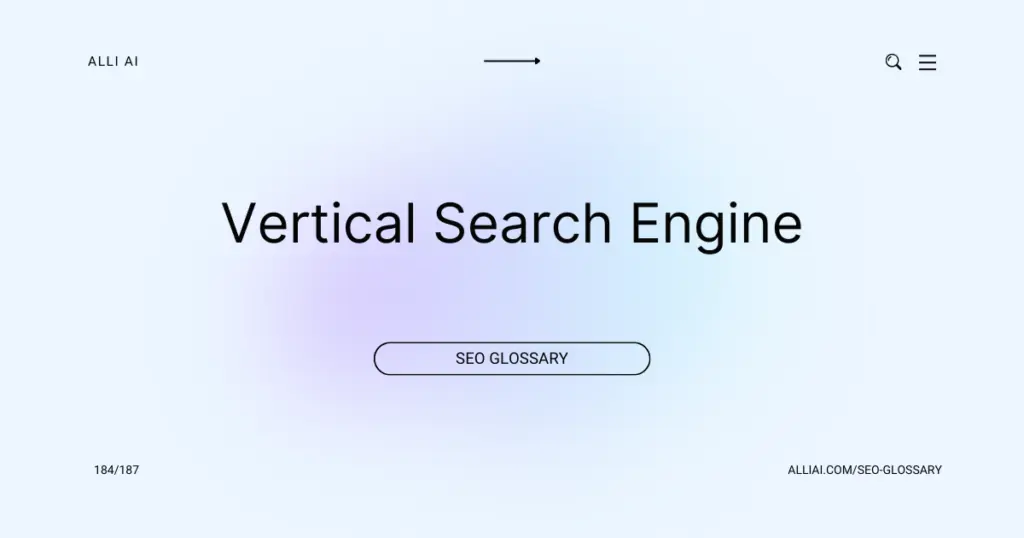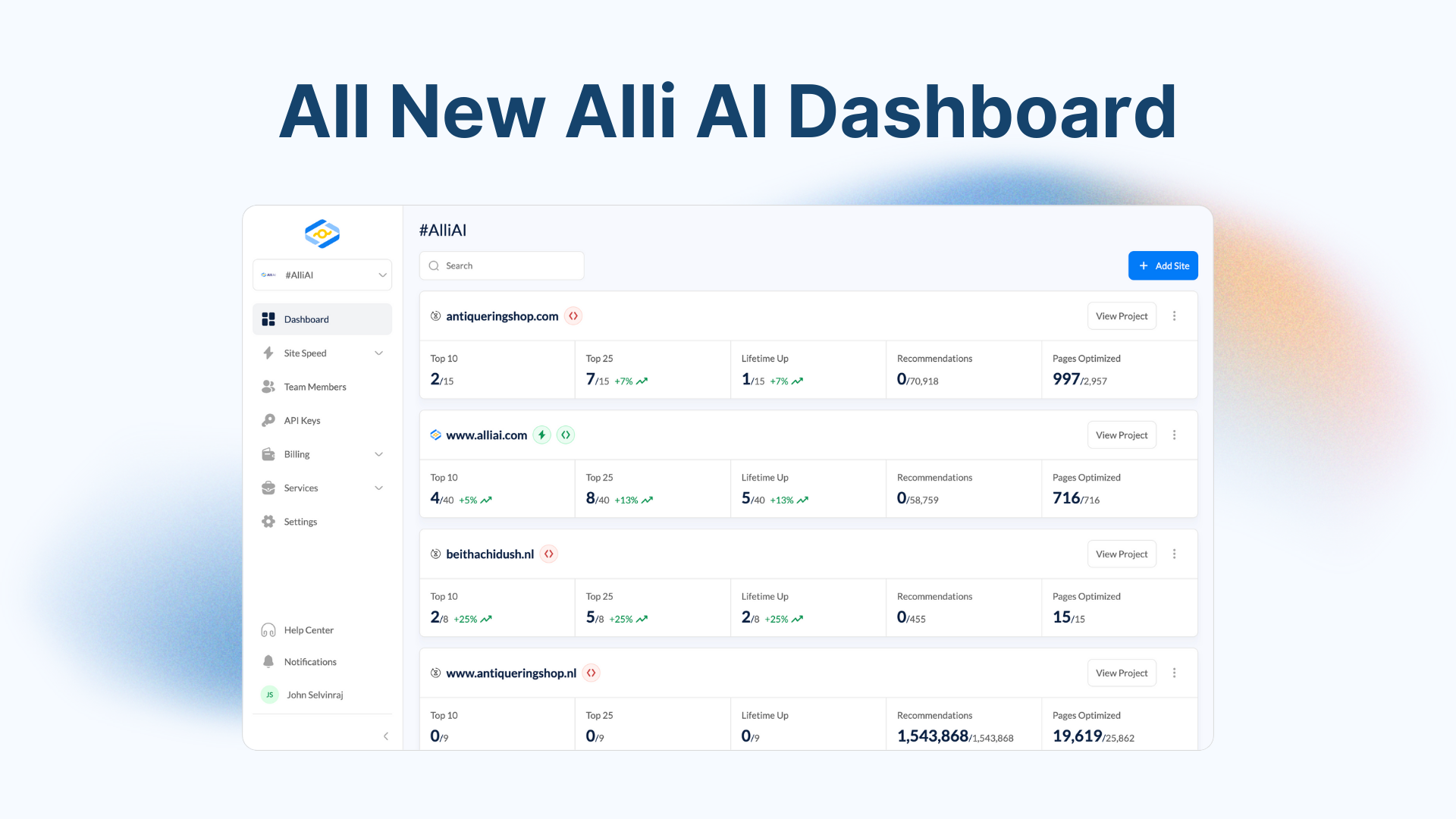What Does Vertical Search Engine Mean?
A vertical search engine is a specialized search engine that focuses on a specific segment of online content or a particular industry, rather than searching the entire web. It aims to provide more precise and relevant results based on particular topics or needs, like jobs, travel, shopping, or real estate.
Where Does Vertical Search Engine Fit Into The Broader SEO Landscape?
Vertical search engines focus on a specific segment of online content, contrasting with general search engines that index a vast range of content across the internet. They are tailored to industries, types of content, or a specific topic, such as Amazon for products, YouTube for videos, and LinkedIn for professional services. From an SEO perspective, optimizing for vertical search engines involves understanding the unique algorithms and ranking factors specific to each type of vertical engine. This can involve optimizing product listings for an e-commerce search engine, enhancing video metadata for video search engines, or improving professional profiles for job-related search engines. By targeting these specific areas, businesses can engage a more targeted audience, potentially leading to higher conversion rates than general search engines. Integrating vertical SEO into a broader SEO strategy enables businesses to capture niche markets and address specific user intents effectively, complementing the broader goals of increasing visibility and authority across the internet.
Real Life Analogies or Metaphors to Explain Vertical Search Engine
1. Library Special Collections Room: A vertical search engine is like a special collections room in a library. While the main library offers books on a vast array of topics, the special collections room focuses on a particular subject, providing deeper and more specific resources within that field.
2. Specialty Boutique: Imagine a large shopping mall where you can buy almost anything. A vertical search engine is like one of those small, specialty boutiques that focuses solely on one type of product, such as high-end cosmetics or outdoor sporting gear, offering a curated selection that caters specifically to enthusiasts of that niche.
3. Gourmet Food Market: Just as a gourmet market specializes in fine foods and catering to specific culinary tastes, as opposed to a general supermarket which stocks a little of everything, a vertical search engine narrows its focus to serve the needs of users interested in a specific topic or industry.
4. Museum Exhibition: If a general search engine is like an entire museum, a vertical search engine is like a specific exhibition within that museum. This exhibition is dedicated to a particular theme or type of art, providing visitors with a focused, enriching experience on that subject.
5. Wildlife Specialist Vet: Think of a general veterinarian as a general search engine, capable of treating a wide range of animals. In contrast, a vertical search engine is like a veterinarian specializing in wildlife, equipped with specific knowledge and tools to treat wild animals exclusively.
How the Vertical Search Engine Functions or is Implemented?
1. Indexing Specific Data: Vertical search engines focus on a particular segment like travel, jobs, or real estate, applying crawlers or APIs to gather specific types of data only relevant to their niche.
2. Data Structuring: Collected information is structured in a manner that adds value to the niche audience. This includes classifications, tagging, and categorizing data based on predefined criteria.
3. Search Algorithm: Algorithms are tailored to the niche, prioritizing factors such as relevance, user context, and specialized data attributes (e.g., location for real estate searches, experience level for job searches).
4. Customized User Experience: User interfaces and search functionalities are customized to meet the needs of the niche audience, including filters and advanced search options that are relevant to the specific vertical.
5. Ranking System: Search results are ranked based on criteria significantly more tailored than general search engines, possibly integrating user reviews, expert ratings, or specific metadata.
6. Search Results Presentation: The presentation of search results often includes enriched data displays such as maps for real estate, salary ranges for jobs, and schedule options for flights in travel searches.
7. Continuous Optimization: Vertical search engines continuously refine data acquisition, algorithms, and user interaction elements based on user feedback and changing trends within the niche to deliver more precise and useful information.
Impact Vertical Search Engine has on SEO
Vertical search engines focus on a specific segment of online content, affecting SEO performance and user experience by:
1. Niche Targeting: They enable websites to attract more focused and relevant audiences, improving the quality of traffic and potential for higher conversion rates.
2. Reduced Competition: Specialized search environments reduce the level of competition compared to general search engines, potentially boosting rankings for niche sites.
3. Content Optimization: Websites optimize their content to meet the specific criteria and standards of vertical search engines, which can enhance visibility and authority within that niche.
4. User Experience Enhancement: Vertical search engines often provide more tailored and relevant results, improving user satisfaction and engagement with the site’s content.
5. Increased Visibility: Listing in these specialized engines can increase a website’s visibility to a targeted audience, often leading to more direct traffic.
6. SEO Strategy Diversification: Incorporating vertical search optimization into an SEO strategy can help diversify traffic sources and reduce dependency on major search engines.
7. Quality Backlinks: Being featured in a reputable vertical search engine can lead to high-quality backlinks from other niche-focused sources, enhancing overall SEO performance.
SEO Best Practices For Vertical Search Engine
1. Identify Your Target Keywords: Research and select keywords relevant to your vertical industry. Utilize tools like Google Keyword Planner, Ahrefs, or SEMrush for finding keywords with good search volume and lower competition.
2. Optimize Your Website’s Content: Integrate the target keywords into your website’s content, including titles, meta descriptions, alt tags, headers, and body text. Ensure that the content is informative, engaging, and relevant to your target audience.
3. Create Quality Backlinks: Build backlinks from reputable sites within the same vertical. Use guest blogging, partnerships, and influencer collaborations to gain authoritative links.
4. Utilize Structured Data Markup: Implement schema markup to help search engines understand the content of your site better. This can include organization schema, product schema, or any other relevant schema to your industry.
5. Optimize for Local Search (if applicable): Make sure your business is listed accurately on Google My Business and other relevant local listing sites. Keep your NAP (Name, Address, Phone Number) consistent across all platforms.
6. Improve User Experience (UX): Ensure that your website is navigable, has a fast load time, and is mobile-friendly. A good user experience on your site can lead to better engagement, which search engines take as a positive signal.
7. Create Vertical-Specific Content: Publish in-depth content that addresses the needs and interests of your industry such as white papers, case studies, how-to guides, and more.
8. Engage with Your Community: Regularly engage with users on social media, forums, and other community platforms relevant to your vertical. This helps in building brand credibility and can often drive direct traffic.
9. Monitor Your SEO Performance: Use tools like Google Analytics and Google Search Console to track your website’s performance. Monitor metrics like traffic, bounce rate, and conversion rate, and adjust your strategies as needed.
10. Use PPC Advertising: Complement your organic efforts with PPC campaigns targeting your vertical. This is useful for capturing traffic for highly competitive keywords where it is difficult to rank organically in the short term.
11. Regularly Update Your Website: Keep your site’s content fresh and routinely updated. This not only helps in keeping your visitors engaged but also signals the search engines that your site is active and relevant.
12. Handle Reviews and Ratings: Encourage customers to leave positive reviews, and promptly address any negative feedback. High ratings can enhance trustworthiness and attract more users from search engines.
By following these steps diligently, you can optimize your presence on any vertical search engine effectively.
Common Mistakes To Avoid
1. Ignoring Platform-Specific SEO: Each vertical search engine has its unique algorithms and ranking factors. Optimize specifically for the platform whether it’s for images, videos, news, or specific industries.
2. Neglecting User Intent: Users come to vertical search engines with specific intents, which can differ significantly from general search engines. Identify and focus content to match these intents precisely.
3. Overlooking Local and Niche Market Trends: Vertical search engines often cater to niche markets. Not staying updated with these markets can hinder your relevance and authority within the vertical.
4. Inadequate Structured Data Implementation: Vertical search engines rely heavily on structured data to understand and categorize content correctly. Inconsistent or incorrect structured data can lead to poor visibility.
5. Not Utilizing Vertical-Specific Features: Failing to utilize platform-specific features like tagging, categorization, or specialized formatting options can result in less effective content presentation and reduced user engagement.
6. Ignoring Mobile Optimization: Given the specialized nature of vertical search engines, many users interact via mobile devices. Neglecting mobile optimization can significantly impact user experience and SEO performance.
7. Poor Content Quality or Relevance: Content that does not meet the high-quality standards expected by vertical search engine algorithms will struggle to rank well.
8. Relying Solely on Vertical SEO: Overdependence on a single vertical can be risky. Diversify your SEO strategy to include both vertical and traditional SEO efforts.
9. Not Monitoring Changes in Vertical Search Algorithms: Like traditional search engines, vertical engines frequently update their algorithms. Regular monitoring and adapting to these changes are crucial.
10. Failing to Analyze Competitor Strategies: Competitor analysis can provide insights into what works well in your target vertical. Ignoring this aspect can result in missed opportunities and suboptimal performance.
11. Ignoring the Integration of Multimedia Elements: Depending on the type of vertical search engine, integrating relevant multimedia elements like images, videos, and infographics can enhance visibility and engagement.
12. Lack of A/B Testing: Not testing different strategies or content types to see what performs best in a vertical market can leave you operating on assumptions rather than data-driven strategies.






